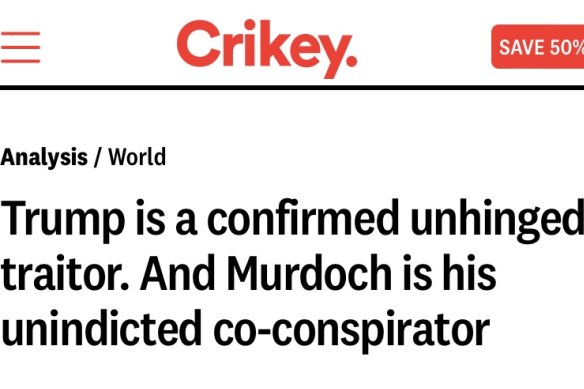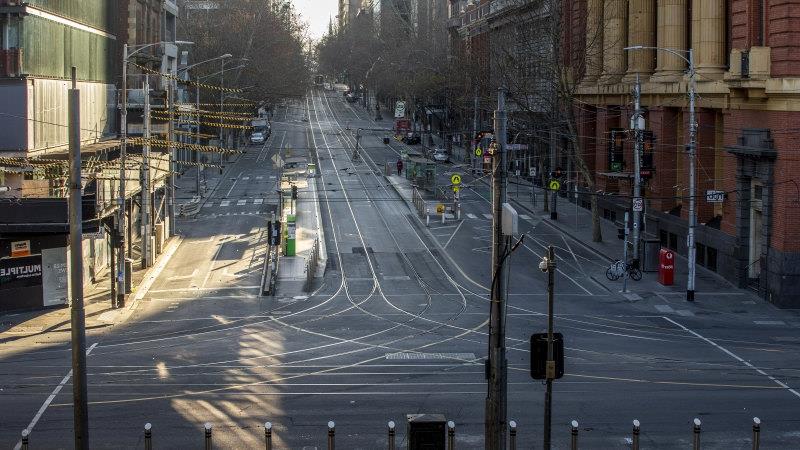Online news outlet Crikey has handed over internal documents about its marketing campaign involving Lachlan Murdoch as part of its Federal Court defamation fight with the media scion.
The parties are locked in a protracted dispute about evidence ahead of the trial, which is set to start on March 27.
Eric Beecher, the chairman of Private Media, the publisher of Crikey (left); Trump supporters outside the Capitol in 2021; and Lachlan Murdoch.Credit:Thom Rigney, AP, Getty
Sydney barrister Sue Chrysanthou, SC, acting for Murdoch, confirmed at a pre-trial hearing on Thursday that the News Corp co-chairman would give evidence in court next year. As is standard, the parties will attend mediation before the trial in an attempt to settle the case.
On Thursday Justice Michael Wigney admitted into evidence a letter sent by Crikey’s lawyer on November 30 to Murdoch’s lawyer attaching an email chain and a document headed “Crikey Murdoch campaign”.
A June 29 article, republished on August 15, is at the centre of Lachlan Murdoch’s Federal Court defamation suit against Crikey.
Chrysanthou said the annexures “were previously significantly redacted”.
Murdoch, chief executive of Fox Corporation and eldest son of media baron Rupert, filed defamation proceedings in August against Crikey over a June 29 article describing his family as “unindicted co-conspirators” of former US president Donald Trump following the deadly US Capitol riots in 2021.
The article was removed from Crikey’s website a day later on June 30, after Murdoch’s solicitor wrote to the news outlet, before being republished on August 15.
Clarissa Amato, acting for Crikey’s publisher Private Media, said there was no dispute about the existence of the marketing campaign and media consultants Populares had been engaged.
She said the news outlet had provided “extensive discovery” – a pre-trial process providing access to documents – including a document headed “Lachlan Murdoch campaign”.
The Murdoch camp was now seeking access to more information about conversations or meetings about the campaign, Amato said, but “they’re just not necessary”.
Murdoch claims the article conveys up to 14 false and defamatory meanings including that he “illegally conspired with Donald Trump to incite an armed mob to march on the Capitol” following the 2020 presidential election.
Crikey denies any of the alleged meanings were conveyed. The publisher also disputes that the article satisfied a new serious harm test, aimed at weeding out trivial claims, which requires the person bringing a defamation case to show that the publication “has caused, or is likely to cause, serious harm” to their reputation.
If the court finds at least some of the meanings were conveyed and the serious harm test is satisfied, Crikey is seeking to rely in part on a new public interest defence that started last year in NSW.
Chrysanthou has argued the marketing campaign is relevant to the public interest defence, under which Private Media must prove the “defamatory matter” concerned an issue of public interest and it “reasonably believed … the publication of the matter was in the public interest”.
She said reposting the article in August had “nothing to do with public interest journalism” and was to further the marketing campaign, on which Crikey had spent “hundreds of thousands of dollars”.
But Amato said Private Media only had to show it reasonably believed publishing the article was in the public interest when the article was published for the first time on June 29, because the republication was not argued to be a separate publication.
The subsequent campaign would only be relevant to any aggravated damages awarded if Murdoch won, Amato said.
The Morning Edition newsletter is our guide to the day’s most important and interesting stories, analysis and insights. Sign up here.
Most Viewed in National
From our partners
Source: Read Full Article




